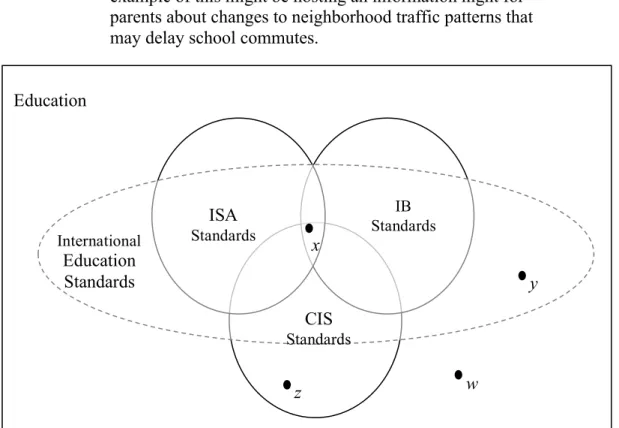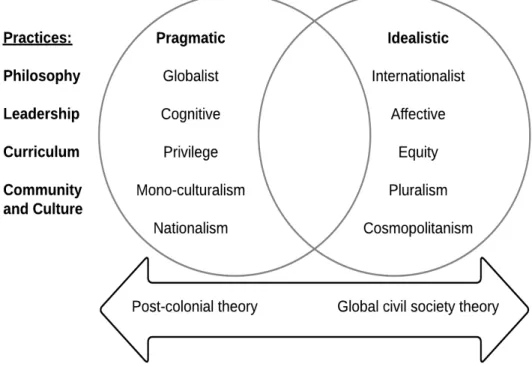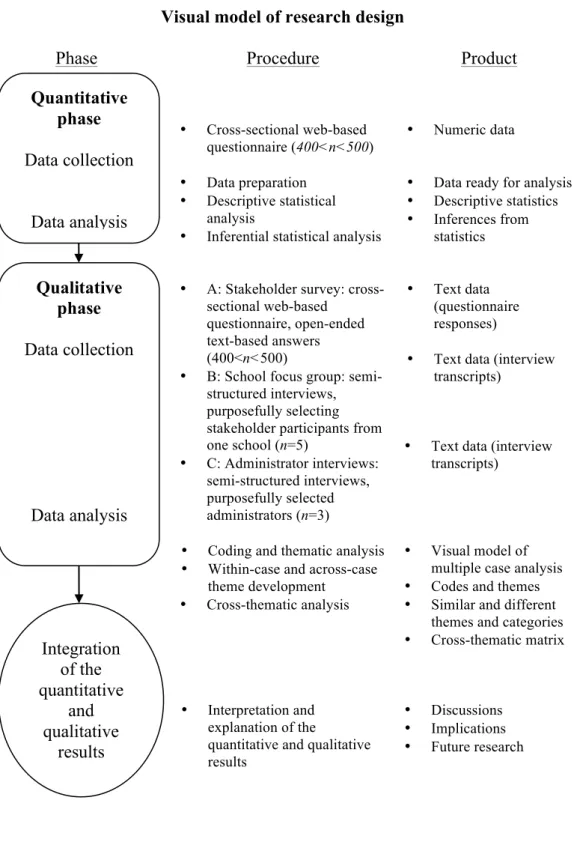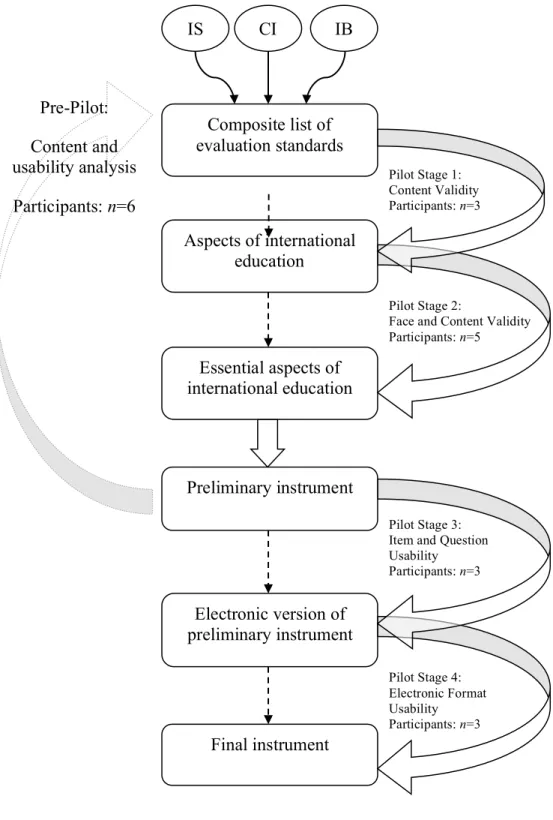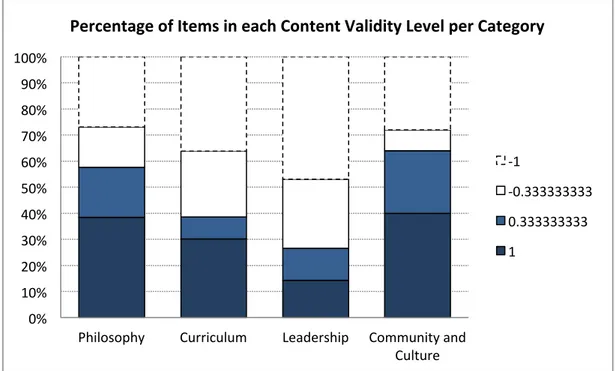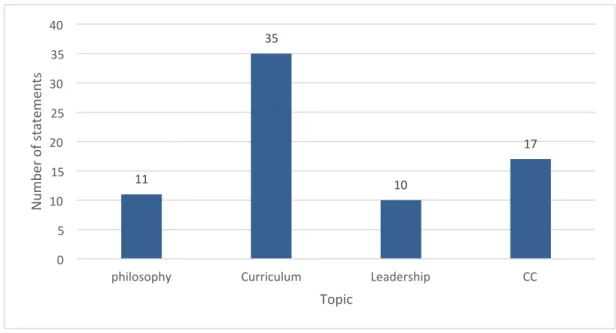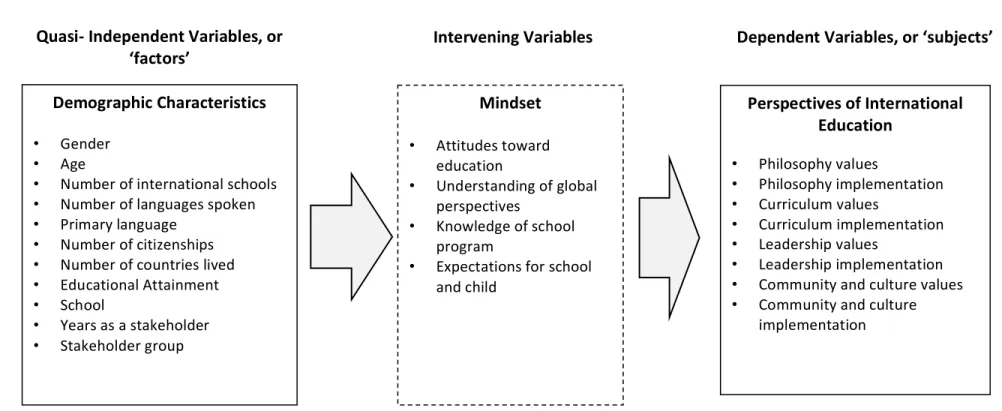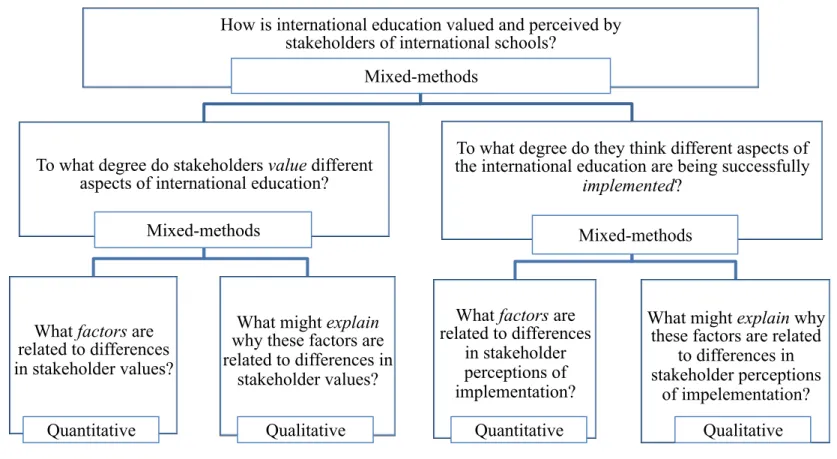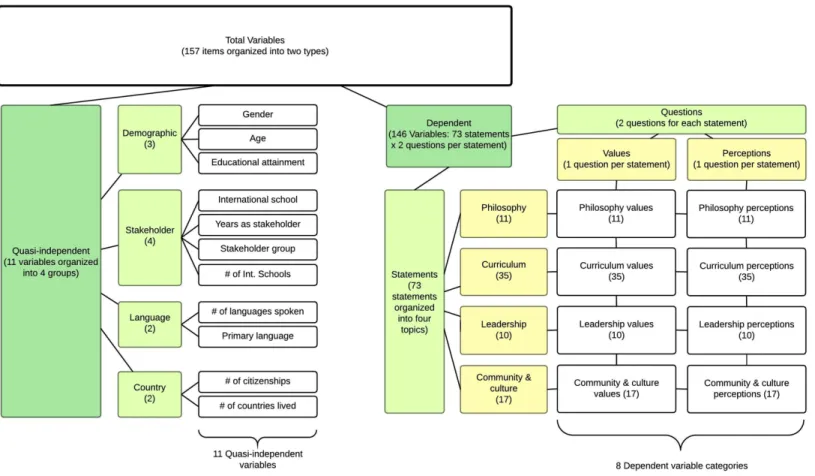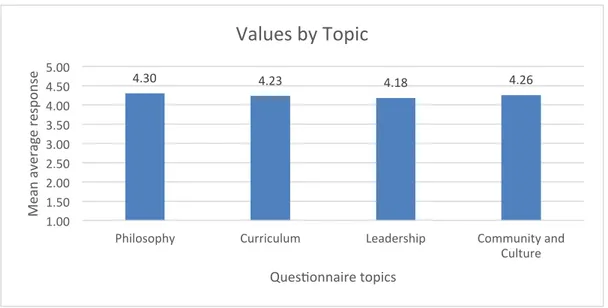INTERNATIONAL EDUCATION CURRICULUM:
STAKEHOLDER VALUES AND PERCEPTIONS
A DOCTORAL DISSERTATION BY
DANIEL JOHN KELLER
THE PROGRAM OF CURRICULUM AND INSTRUCTION
İHSAN DOĞRAMACI BILKENT UNIVERSITY
ANKARA
DEDICATION
This dissertation is dedicated to my wife and children. I am indebted to my best friend, Lara Keller, for whom words could never describe my gratitude for her encouragement and endless support. I am grateful to my two
children, Maddie and Forrest, who have patiently waited for their father to return.
INTERNATIONAL EDUCATION CURRICULUM: STAKEHOLDER VALUES AND PERCEPTIONS
The Graduate School of Education of
İhsan Doğramaci Bilkent University
by
Daniel John Keller
In Partial Fulfilment of the Requirements for the Degree of Doctor of Philosophy in the Program of Curriculum and Instruction
İhsan Doğramaci Bilkent University
Ankara
iii ABSTRACT
INTERNATIONAL EDUCATION CURRICULUM: STAKEHOLDER VALUES AND PERCEPTIONS
Daniel John Keller
Ph.D., Program of Curriculum and Instruction Supervisor: John B. O’Dwyer
May 2015
This study, undertaken with a view to increase understanding of international education, investigates the perspectives of international education held by stakeholders of international schools. Within a theoretical framework which
distinguished an internationalist agenda from a globalist agenda, the extent to which those stakeholders surveyed valued international education was sought, as well as how well the implementation of education matched their expectations. A mixed-methods sequential explanatory study examined stakeholder values and perceptions, using a cross-sectional survey, and related them to demographic and contextual factors. The survey data were subjected to descriptive and inferential statistical analysis. The qualitative phase used three different cross-section methods: survey comments, focus group interviews, and personal interviews, all subjected to thematic and cross-thematic analysis. 483 parent and staff stakeholders of international
schools, part of a corporate for-profit network located in the United Arab Emirates, responded to the survey. Results showed that international education was highly valued by the respondents, with significant differences related to the factors of
school, primary language, educational attainment, and role in school (staff or parent). Stakeholders perceived international education was implemented less well, with significant differences related to the factors of school, number of international schools experienced, and role in school. Explanations related to results described why stakeholders may hold certain perspectives, why differences exist across certain factor categories, and why some differences focus on only part of the construct of international education.
iv ÖZET
ULUSLARARASI EĞITIM PROGRAMI: PAYDAŞ DEĞER VE ALGILARI
DANIEL JOHN KELLER
Doktora, Eğitim Programlari ve Öğretim Tez Yöneticisi: Yrd.Doç.Dr. John O’Dwyer
Mayis 2015
Uluslararası eğitim anlayışını arttırmayı amaçlayan bir bakış açısı ile yürütülen bu çalışma, uluslararası okulların okul topluluklarındaki bireylerin uluslararası eğitime bakış açılarını inceler. Bu çalışmada uluslararası gündemi evrensel gündemden ayıran kuramsal çerçeve dâhilinde okul topluluğundaki bireylerin uluslararası eğitime ne kadar değer verdikleri ve uygulanan eğitimin beklentilerini ne kadar karşıladığı araştırıldı. Birbirini takip eden açıklayıcı nitel-nicel yöntembilim kullanılarak okul topluluğundaki bireylerin değer ve algıları bölümler arası anket kullanarak ve onları demografi ve bağlamsal bağlantılarla ilişkilendirerek incelendi. Anketten elde edilen veri tanımsal ve dolaylı istatistik analizleriyle incelendi. Nitel aşamada üç farklı bölümler arası metot kullanıldı: anket yorumları, odak grup mülakatı ve bireysel mülakatlar. Nitel verilerin tamamının temalar çerçevesinde ve temalar arasında analizleri yapıldı. Birleşik Arap Emirlikleri’nde kurumsal kar amacı güden bir iletişim ağına dâhil olan uluslararası okullardan 483 veli ve çalışan ile anket çalışması uygulandı ve sonuçları alındı. Sonuçlar gösterdi ki ankete katılanlar tarafından uluslararası eğitime çok fazla değer veriliyor ve okul, eğitim dili, eğitime ulaşmak, okuldaki roller (çalışan veya veli) faktörleri arasında anlamlı farklılıklar gözlemlendi. Okul topluluğundaki bireylerin uluslararası eğitimin daha az iyi uygulandığını düşündükleri ve okul, uluslararası okul deneyimi ve okuldaki görev faktörleri arasında anlamlı farklılıklar gözlemlendi. Sonuçlarla ilgili açıklamalar okul topluluğundaki bireylerin neden belli başlı bakış açılarına sahip olduklarını, bazı faktör kategorileri arasında neden farklılıklar olduğunu ve neden bazı farklılıkların sadece yapısal olarak uluslararası eğitim kavramına odaklandıklarını tanımladı.
v
ACKNOWLEDGEMENTS
The creation of a doctoral thesis is a challenge of endurance made possible only by a team of supportive individuals.
I have been blessed by a committee of dedicated, supportive, and accomplished scholars. Chair of the committee, Professor Dr. Margaret Sands, to whom I am deeply indebted, has been an unceasing advocate through all stages of my doctoral program. My Supervisor, Assistant Professor Dr. John B. O’Dwyer, without whom this dissertation would not exist, has provided tremendous patience, guidance, and invaluable feedback throughout this process. My Advisor, Professor Dr. Megan Crawford, who warmly welcomed me to the University of Cambridge as a Visiting Scholar, helped me publish my article and inspired my love of philosophy that is the essence of the degree.
This great committee was part of a larger program filled with people who provided support every step of the way. I would like to thank the program faculty; your teachings help form the threads from which this dissertation has been woven. Thanks to my colleagues Müşerref Saraçoğlu, Jale Ataşalar, and Deniz Cicekoğlu, for their support, encouragement, and friendship. Special thanks to Dr. Ilker Kalender for technical support with inferential statistical analysis and Dr. Fatma Taskin for feedback on the analysis.
The program existed within the very special context of Bilkent University. A very special thanks to the Doğramacı family and their philanthropic creation of Bilkent University. In particular, a special thanks to Professor Dr. Ali Doğramacı for his mentorship, support, and gift of the opportunity to serve as a visiting scholar at the University of Cambridge.
Outside of Bilkent, there were many others who were instrumental in this study. Thanks to University of Bath professors Dr. Jeff Thompson and Dr. Mary Hayden, who were gracious with their time and support in my early days of research. I am appreciative of financial support for this research study by the International
Baccalaureate through their Professor Dr. Jeff Thompson Research Award. Thanks, also, to the International Schools Association for providing, gratis, their proprietary self-study instrument. Finally, thanks to all of the participants and other volunteers for their time and effort.
vi TABLE OF CONTENTS ABSTRACT ... iii ÖZET ... iv ACKNOWLEDGEMENTS ... v TABLE OF CONTENTS ... vi
LIST OF TABLES ... xii
LIST OF FIGURES ... xv
CHAPTER 1: INTRODUCTION ... 1
1.1 Introduction ... 1
1.2 Background to the study ... 2
1.3 Statement of problem ... 5 1.4 Purpose ... 6 1.5 Research questions ... 7 1.6 Significance ... 9 1.7 Definition of terms ... 10 1.8 Summary ... 11
CHAPTER 2: REVIEW OF THE LITERATURE ... 13
2.1 Introduction ... 13
2.2 History and definitions ... 14
2.2.1 International schools. ... 14
2.2.2 International education. ... 18
vii
2.3.1 Nation as a root concept for values. ... 25
2.3.2 Culture as a root concept for values. ... 26
2.3.3 Citizen as a root concept for values. ... 27
2.4 Stakeholders and international education ... 28
2.4.1 Parents as stakeholders. ... 29
2.4.2 Staff and students as stakeholders. ... 30
2.5 Evaluation of international schools ... 32
2.6 Leadership of international schools ... 37
2.7 Theoretical framework ... 41
2.7.1 Dualities in international education ... 42
2.7.2 International education matrix ... 44
2.7.3 International school dualities theoretical framework ... 46
2.8 Research focus ... 51
CHAPTER 3: METHODOLOGY ... 53
3.1 Introduction ... 53
3.2 Positioning the research study ... 54
3.2.1 Inductive reasoning ... 54
3.2.2 Nominalist ontology. ... 54
3.2.3 Constructivist epistemology. ... 55
3.2.4 Neo-positivist and interpretivist theoretical perspectives. ... 56
3.3 Research design ... 57
viii
3.3.2 Overview of the design. ... 58
3.4 Context for the study ... 61
3.5 Phase one: Survey ... 62
3.5.1 Survey design and development ... 63
3.5.2 Piloting the survey ... 69
3.5.3 Methods of quantitative data collection ... 77
3.5.4 Analysis of quantitative data ... 78
3.6 Phase two: Qualitative explanatory research ... 91
3.6.1 Design of qualitative phase ... 91
3.6.2 First source: questionnaire qualitative data ... 94
3.6.3 Second source: focus-group interview ... 94
3.6.4 Third source: administrator interviews ... 96
3.6.5 Analysis of the qualitative data ... 97
3.7 Maintaining standards of ethical research ... 101
3.8 Conclusion ... 102
CHAPTER 4: RESULTS ... 104
4.1 Introduction ... 104
4.2 Overview of the results ... 106
4.2.1 Quantitative phase data ... 106
4.2.2 Qualitative phase data ... 117
4.3 Stakeholder values of international education ... 120
ix
4.3.2 Factors related to differences in stakeholder values ... 134
4.3.3 Explanations for differences in stakeholder values ... 139
4.3.4 Integration of quantitative and qualitative data ... 161
4.4 Stakeholder perceptions of implementation of international education ... 165
4.4.1 Degree of stakeholder perceptions of implementation ... 166
4.4.2 Factors related to differences in stakeholder perceptions of implementation ... 179
4.4.3 Explanations for differences in stakeholder perceptions of implementation ... 185
4.4.4 Integration of quantitative and qualitative results ... 216
4.5 Integrating the results of the research questions ... 223
4.5.1 Difference between stakeholder values and perceptions ... 223
4.5.2 Significant factors for values and implementation. ... 225
4.5.3 Thematic network integrating all results ... 229
4.6 Conclusion ... 231
CHAPTER 5: CONCLUSION ... 234
5.1 Introduction ... 234
5.2 Significance of the study ... 234
5.3 Discussion of the findings ... 236
Finding 1: Stakeholders value international education as highly important. .... 237 Finding 2: Significant differences in stakeholder values of international
x
education are related to the factors of international school, educational attainment, stakeholder group, and primary
language. ... 239
Finding 3: Significant variations in the relationship between stakeholder values and demographic factors are explained by the themes of philosophy, internationalism, cultural tensions, corporate/for profit education and academic priority. ... 241
Finding 4: Stakeholders perceive that international education is implemented less than well. ... 248
Finding 5: Significant differences in stakeholder perceptions of international education implementation are related to the factors of international school, number of international schools, and stakeholder group. ... 249
Finding 6: Significant variations in the relationship between stakeholder perceptions and demographic factors is explained by the themes of general context, philosophy, management, communication, teaching, stakeholder role, and curriculum. ... 253
Finding 7: International school stakeholders value international education at significantly higher levels than they perceive its implementation. . 262
5.4 Implications for practice ... 264
5.5 Implications for further research ... 265
5.6 Limitations ... 268
xi
REFERENCES ... 272
APPENDICES ... 286
Appendix A: Informed Consent ... 287
Appendix B: Letter to potential interview participants ... 288
Appendix C: Letter to interview participants ... 289
Appendix D: Informed consent form for interview participants ... 290
Appendix E: Semi-structured interview protocol ... 291
Appendix F: Letter to potential participating schools ... 293
Appendix G: Semi-structured interview protocol ... 294
Appendix H: Variables by Category, Type and Scale ... 296
Appendix I: Paired T-test SPSS Results ... 297
Appendix J: MANOVA Test SPSS Results ... 298
Appendix K: ANOVA Tests SPSS Results ... 300
xii
LIST OF TABLES
Table
1 Efforts to describe international schools ... 18
2 Overview of some efforts to describe international education ... 24
3 Dualities framework practices: Comparison to major evaluation schemes ... 48
4 Comparison of universe of international schools to target sample ... 62
5 Estimated target populations by study phase ... 64
6 Sample of items, relation to agendas, and action taken ... 66
7 Pre-pilot study feedback and actions taken ... 70
8 Instrument questions by topic and category ... 76
9 Timeline of quantitative data collection ... 78
10 Research question and method of statistical analysis ... 79
11 Quasi-independent variables ... 81
12 Dependent variables ... 82
xiii
14 Response coding for independent variable responses ... 86
15 Description of mean average calculations ... 87
16 Qualitative phase sources overview ... 93
17 Timeline of quantitative data collection ... 94
18 Population, sample size and response rate ... 108
19 Quantitative data set ... 108
20 Demographic variables frequency data ... 111
21 Stakeholder variables frequency data ... 112
22 Language variables frequency data ... 114
23 Country variables frequency data ... 115
24 Reliability of quantitative data: Chronbach's Alpha statistic ... 116
25 Multiple analysis of variance (MANOVA): Factors and related significance levels ... 117
26 Qualitative frequency data (source one) ... 119
27 Qualitative frequency data (source two) ... 119
xiv
29 Values: Analysis of variance (ANOVA) by factors and topics ... 136
30 Values: cross-case analysis ... 156
31 Perceptions: Analysis of variance (ANOVA) by factors and topics ... 181
32 Perceptions mean average and significance level ... 183
33 Implementation: cross-case analysis ... 211
xv
LIST OF FIGURES
Figure
1 Illustration of research questions and related concepts ... 8
2 Sylvester's matrix model for defining international education ... 20
3 Visual representation for conceiving standards for international education ... 36
4 Visual representation of the International School Dualities Theoretical Framework ... 51
5 Visual model of research design ... 60
6 Stages of instrument production and pilot study ... 68
7 Content validity levels by item category ... 73
8 Frequency of statements by topic ... 76
9 Visual representation of relationships among variables during quantitative phase ... 83
10 Qualitative phase data collection process ... 96
11 Research questions and related research methods ... 105
12 Organization of variables in study ... 109
13 Overview of values: Mean average responses by topic ... 122
14 Values: Gender by topic ... 123
xvi
16 Values: Education by topic ... 124
17 Values: School by topic ... 126
18 Values: Stakeholder years by topic ... 126
19 Values: Stakeholder group by topic ... 127
20 Values: Number of schools by topic ... 128
21 Values: Languages by topic ... 129
22 Values: Primary language by topic ... 130
23 Values: Citizenship by topic ... 131
24 Values: Countries by topic ... 132
25 Values thematic network diagram ... 160
26 Values: Integration of quantitative and qualitative results ... 163
27 Overview of perceptions: Mean average responses by topic ... 167
28 Perceptions: Gender by topic ... 168
29 Perceptions: Age by topic ... 168
30 Perceptions: Education by topic ... 169
31 Perceptions: School by topic ... 170
32 Perceptions: Stakeholder years by topic ... 171
33 Perceptions: Stakeholder group by topic ... 171
xvii
35 Perceptions: Languages by topic ... 174
36 Perceptions: Primary language by topic ... 174
37 Perceptions: Citizenship by topic ... 176
38 Perceptions: Countries by topic ... 176
39 Implementation: thematic network diagram ... 215
40 Perceptions: Integration of quantitative and qualitative results ... 218
41 Average Responses by topic (among all schools) ... 224
42 Paired T-test for values and perceptions ... 226
CHAPTER 1: INTRODUCTION
1.1 Introduction
International school stakeholder perspectives of an international education curriculum are formed through complex interactions of multiple factors. These perspectives reflect how stakeholders value certain aspects of the international education curriculum and how they perceive that curriculum is being implemented. The perspectives of stakeholders, therefore, may be examined through both their values and perceptions of implementation.
Stakeholder values and perceptions of international education may be related to two sets of factors: a stakeholder’s demographic characteristics such as their role in the school or the number of international schools they have attended; or the context within which an international school exists such as government regulations, cultural influence, and expatriate diversity.
This research study aims to help increase our understanding of the world of international education by exploring international school stakeholder perspectives through careful examination of stakeholder values and perceptions, and how they related to demographic and contextual factors.
This chapter introduces the study with seven sections: a) background to the study, b) statement of problem, c) purpose, d) research questions, e) significance, f)
limitations, and g) definition of terms. It concludes with a brief review of this chapter and an overview of the remaining chapters of this dissertation.
1.2 Background to the study
International schools were originally established with differing agendas for providing international education. Globalization has fueled the growth in the number of
international schools, which now represent a sizeable niche within the field of education. Bringing clarity of standards to this niche, and leading individual international schools, is a challenging endeavor.
In 1866, the Spring Grove School in London was founded with a curriculum that explicitly focused on the ideals of internationalism (Sylvester, 2002). The International School of Geneva was founded in order to serve the children of employees working for the League of Nations (International School of Geneva, 2015). Each school has been labeled as ‘the first’ international school in the world. The disagreement may have less to do with questions of historical accuracy than it has to do with meaning of the term international school; a term that lacks a common definition (Cambridge & Thompson, 2001).
Spring Grove School was established for idealistic reasons: for students to have the opportunity to participate in a curricular program designed to impart certain ideals. International School of Geneva was established for pragmatic reasons: “There was the need for a school which would cater for students with a diversity of cultures and would prepare them for university education in their home countries” (International School of Geneva, 2015). Even in the birth of international schools, two different reasons existed for the creation of such schools: the pragmatic agenda and the
idealistic agenda. The duality of these agendas continues to exist within
Grove. The growth of international schools may be linked to the concept of
globalization. In the case of Spring Grove, it could be argued that globalization led
to the concept of international-mindedness. In the case of International School of Geneva, it could be argued that globalization led to the concept of the League of Nations. Globalization, therefore, is also inextricably connected to both pragmatic and idealistic agendas (Eden & Lenway, 2001).
As the economic processes of globalization continue to expand, they fuel the exponential growth of international schools (Brummit, 2011). As the international trade of goods and services continues to grow, there is an increasing number of expatriate employees needing international schools for their children. In addition, the advantages of English language schools promise economic advantage to the growing middle class of host-country nationals from developing countries, further fueling demand for international schools (Hayden & Thompson, 2013). These processes have led to what Greenlees (2006) refers to as the ‘staggering’ demand far exceeding the supply of international schools. Today, there are over 7,600
international schools serving 3,993,797 students throughout the world (ISC Research Limited, 2015). Not surprisingly, this excess demand has been detected as an
opportunity for profit-making; the majority of new international schools are part of
corporate for-profit networks (Brummit, 2011).
The field of international education, with the exponential growth of international
schools, lacks commonly agreed upon definitions (Haywood, 2002). Within this
ambiguous context of exponential growth, the field of international education has entered an unprecedented phase of structure, standards, and evaluation (Bunnell, 2008). International education organizations, such as the Council of International
have established standards for evaluating international schools (Crippin, 2008). These evaluation standards tend to cover a range of practices, including curriculum,
leadership, community and culture, and philosophy.
The philosophy of international education is historically rooted in values addressing the concepts of nation, culture, and citizenship (Cambridge, 2003). If an
international school philosophy is more idealistic, it may focus on a more affective curriculum that emphasizes internationalism, pluralism, cosmopolitanism, and equity. This idealistic agenda of international schools, viewed from the perspective of global civil society theory, would serve the needs of less privileged people
throughout the world in order to address issues of poverty, justice, and human rights (Keane, 2003). Alternatively, if a philosophy is more pragmatic, it may focus on a more cognitive curriculum that exploits globalization, cultural advantage, national influence, and privilege (Cambridge, 2003). The pragmatic agenda, viewed from a
post-colonial theory perspective, serves the needs of wealthy expatriates in order to
maintain their economic advantage in the world (Crossley & Tikly, 2004).
The standards used to evaluate international schools may be influenced by these different philosophical positions. International schools may be defined by how they resolve the tensions between these opposing positions (Cambridge & Thompson, 2001). It is unclear the degree to which international school stakeholders value these different perspectives (Cambridge & Carthew, 2007).
Leadership of international schools, therefore, may require managing uncertain stakeholder perspectives in a poorly defined context while pursuing conflicting agendas (Keller, 2014). Leadership of international schools has unique dimensions that require distinct skills and knowledge (Haywood, 2002). Some of the most
intense challenges of international school leadership may be related to managing stakeholder community dynamics (Caffyn, 2011). Understanding stakeholder values and perceptions may be helpful to leaders facing these unique challenges that are inherent to the international school context (Connor, 2004).
1.3 Statement of problem
In order for international schools to fulfill their missions, they must maximize the degree to which stakeholders commit toward that mission (Knapp, Copland, & Talbert, 2003). Leaders must work with their school’s community of stakeholders to build common understanding of, and commitment to, the school’s mission (Corbett & Wilson, 2007; McREL, 2006; Sergiovanni, 2001; Smyth, 2006).
There are, however, significant challenges in accomplishing this task. The key terms
international school and international education defy common definitions. The field
of international education is defined by tensions between pragmatic and idealistic agendas. Various organizations provide different evaluation standards that must be met for schools to earn accreditation and authorization. Sources suggest that competition among international schools is increasing within certain market places and that corporate for-profit school networks may be a significant contribution to that increased competition (Brummit, 2011; Cambridge & Thompson, 200; Greenlees, 2006). Ambiguity, tension, complexity, and competition are not ideal conditions for building community commitment toward a school mission.
International school leaders, if they are to be successful in helping their schools successfully pursue their mission, need to resolve contextual issues related to
stakeholder perspectives and competing agendas. There is a gap in the knowledge of stakeholder perspectives of international education. Need arises, therefore, to
examine how stakeholders value and perceive the implementation of international education. This study investigated how international school stakeholders value, and perceive implementation of, international education evaluation standards.
1.4 Purpose
The purpose of this mixed-methods sequential explanatory study was to investigate perspectives of international education held by stakeholders of international schools.
The exploratory quantitative phase conducted non-experimental descriptive research using a cross-sectional survey method. Quasi-independent variables included general stakeholder characteristics and demographic characteristics. Dependent variables addressed values and perceptions of international education. The quantitative data was subjected to descriptive and inferential statistical analysis.
The explanatory qualitative phase conducted descriptive research using three different cross-section methods: survey comments, focus group interviews, and personal interviews. The qualitative data were subjected to thematic and cross-thematic analysis.
The population included parent and staff stakeholders of international schools that are part of a corporate for-profit network located in the United Arab Emirates. The questionnaire, which supplied quantitative data and the first source of qualitative data, was convenience sampling within a purposefully targeted population. The second and third sources of qualitative data utilized purposeful sampling to maximize access.
1.5 Research questions
This study contributes to our understanding of international education by exploring the question: “How is international education valued and perceive by stakeholders in international schools?” This question may be explored with further research
questions related to values and perceptions. Each of those questions leads to further questions exploring factors that might be identified through inferential statistical analysis, and explanations which might be identified through qualitative thematic analysis. The research questions, sub-questions, and sub-sub questions include the following:
• Primary research question: “How is international education valued and perceived by stakeholders in international schools?”
1. Sub-question: To what degree do they value different aspects of international education?
a) What factors are related to differences in stakeholder values? b) What might explain why these factors are related to differences in
stakeholder values?
2. Sub-question: To what degree do they think different aspects of the international education are being successfully implemented?
a) What factors are related to differences in stakeholder perceptions of implementation?
b) What might explain why these factors are related to differences in stakeholder perceptions of implementation?
Figure 1 illustrates these research questions and how they are related to the concepts of stakeholders, international education, and international schools. The arrow
pointing from international education to international schools is intended to indicate that the concept of international education is implemented within a specific
international school. The arrows pointing from stakeholder to international education and international schools is intended to indicate that stakeholders have values about international education as a concept and have perceptions of how they are implemented within an international school.
Figure 1. Illustration of research questions and related concepts
a) What factors are related to differences in stakeholder values? b) What might explain why these factors are related to differences in stakeholder values? International Education International Schools Stakeholders 2) To what degree do they think different aspects of the international education are being successfully implemented? 1) To what degree do they value different aspects of international education?
a) What factors are related to differences in stakeholder perceptions of implementation? b) What might explain why these factors arerelated to differences in stakeholder perceptions of implementation?
How is international education valued and perceived by stakeholders in international schools?
1.6 Significance
The general rationale for this study addresses increasing our understanding of international education, and more specifically, our understanding of international school leadership. Defining international schools, and the curriculum that they could best follow, is one of the central and continuing issues of concern in the field of research related to international education (Dolby & Rahman, 2008). Additional research in the rapidly developing context of international schools and international education is necessary (Mackenzie, Hayden, & Thompson, 2003). In addition, administrators in international schools need support to develop the necessary
leadership skills unique to the field of international education (Haywood, 2002), not least to ensure that the curriculum and instruction therein is appropriate, relevant and valuable.
This study is timely. International schools are growing at a considerable rate for a variety of factors ranging from general factors, such as increasing globalization, to specific factors, such as increases in host-country national interest in international schools. Hand in hand with growth, there is a variety of curricula as well as instructional methods. No one curriculum has been agreed as necessary for an international school or to implement international education. The entrance of corporate for-profit education on a major scale (Brummit, 2011) has added to the number of schools and the variety of curricula delivered. The population of this study is for-profit schools in the Middle East; representing the type of school and region that currently constitutes the greatest growth in the international school market (Brummit, 2011).
international schools. It also has relevance to the broader fields of school leadership and general education. In addition, international education is an increasingly
important part of dialogue related to national education system reform (Rizvi, 2015) and the findings may extend beyond the specific context of this study.
The study contributes to the fund of knowledge about international schools and international education. While previous studies have established initial
understanding of stakeholder perceptions of international education, there continues to be a call for further data (Hayden & Thompson, 1997, 1998; Mackenzie, Hayden, & Thompson, 2003). Minimal research exists related to international school
evaluation processes (Fertig, 2007). The study further contributes to previous studies (Cambridge & Thompson, 2001) related to pragmatic/idealistic dualities within international schools.
1.7 Definition of terms
This research study examines the perceptions of international education that are maintained by various stakeholders within different international schools.
The study considers international schools as unique schools operating within a specialty niche of the education sector. For the purposes of this study, the term
international school is operationally defined as “a school that provides an
international curriculum other than the local curriculum, and/or provides instruction in a language other than the host-country language” (Brummit, 2011). It should be noted that each international school is considered to have a unique context within which it operates, but the curriculum remains distinctly international in character.
defined as “an approach to education that pursues the dual priorities of meeting the educational needs of internationally-mobile families and developing a global perspective in students” (Cambridge & Thompson, 2001). It should be noted that this ‘approach to education’ is usually reflected in the curriculum and instructional methods throughout the school.
For the purposes of this study, the term global perspective is operationally defined as “a perspective that pursues international-mindedness, intercultural sensitivity, and globally-oriented citizenship in order to promote world peace and justice.”
For the purposes of this study, stakeholder group is operationally defined as “any group of people who have a direct interest in the education provided by the school.” Examples of such groups may include students, parents, teachers, support staff, administrators, and board members. This study specifically examines two stakeholder groups: parents and faculty members.
This study implements certain abbreviations for three international education organizations that are an integral part of this study:
CIS: Council of International Schools
IB: International Baccalaureate
ISA: International Schools Association
1.8 Summary
This introductory chapter has provided background to the study, established the research problem, described the purpose of study, identified the research questions, determined the significance, stated the limitations, and defined key terms.
Chapter two, which reviews the literature related to the study, consists of seven sections: a) history and definitions, b) values related to international education, c) stakeholders and international education, d) evaluation of international schools, e) leadership of international schools, f) theoretical framework, and g) research focus.
Chapter three, which describes the methodology of the study, consists of six sections: a) positioning the research study, b) research design, c) context for the study, d) phase one, e) phase two, and f) maintaining standards of ethical research.
Chapter four, which provides the results of the study, consists of four parts: a) overview of the results, b) stakeholder values of international education, c) stakeholder perceptions of implementation of international education, and d) integrating the results of the research questions.
Chapter five, which provides the conclusions of the study, consists of five parts: a) significance of the study, b) discussion of the findings, c) implications for practice, d) implications for further research, and e) limitations.
CHAPTER 2: REVIEW OF THE LITERATURE
2.1 Introduction
This chapter reviews the literature related to how international education is valued and perceived by stakeholders in international schools. The literature was selected by first reviewing relevant scholarly research related to international education,
supplemented with two other bodies of literature: general educational research and research from outside of the field of education.
The chapter consists of six sections. The first section explores the history and definitions behind the terms international education and international school. Different definitions for these terms are critically analyzed. Next, values related to international schools are discussed, including an exploration of the values emanating from three organizing concepts: nation, culture, and citizen. The third section
reviews the literature on international school stakeholders and their values related to international education. The pragmatic and idealistic priorities behind stakeholder understandings of international education are explored. The fourth section critically analyzes the evaluation schemes from three prevailing international school
organizations: the Council of International Schools, the International Baccalaureate Organization, and the International Schools Association. The limitations of each evaluation scheme are analyzed. The fifth section reviews the literature related to leaders of international schools and explores the challenges leaders face as they make sense of the various values and perceptions held by different stakeholders of
international schools. The final section establishes a theoretical framework for this study, which draws upon two theories: post-colonial theory and global civil society theory. The conclusion summarizes the relevant findings in the literature and
establishes the need for the primary research questions of this study.
2.2 History and definitions
Four major approaches to defining the term “international school” will be used for the purposes of analysis in the section 2.2.1: community; structure; affiliations; and education. Five efforts to describe “international education” will be explored in section 2.2.2: research trajectories, international/political matrix, multiple-tensions, competing agendas, and curriculum/ ideology dichotomy.
2.2.1 International schools.
Defining the term international school poses some challenges. Schools are not required to meet certain requirements to call themselves international (MacDonald, 2006), and schools that do use the title are tremendously varied with relation to origin, type, and many other factors (Sylvester, 2003).
One approach to defining international schools is to look at the school community. A school might be defined as international if its students, parents, staff, or board originate from outside the host country. Terwilliger (1972) identifies five defining characteristics of an international school: student diversity, a board reflective of the student body, a faculty experienced in cultural adaptation, the study of multiple languages, and a curriculum that draws from a broad range of sources. The first three of the five characteristics focus on the school community, which suggests the
importance of school population as a defining characteristic of international schools. With recent demographic changes in major metropolitan areas, a large number of schools might now meet the three-community criterion. While some evidence
& Thompson, 1997), other studies suggest that simply increasingly diversity can perpetuate normative national, cultural and ethnic identities (Matthews & Sidhu, 2005). Some critics, therefore, question whether diversity in a school community is sufficient for a school to be called international (Hayden & Thompson, 1995). Leach recognized the problems related to referring to schools as 'international' based on the student body:
It would appear to be common practice in a number of places to regard an international school as one serving or being composed of students from several nationalities. This definition leads into hopeless confusion, however, when, upon reflection, one realises that practically every school in such a cosmopolitan centre as London or New York includes a number of nationalities in its student body. Such schools are mostly state-financed national institutions. There are, in fact a number of privately financed and some state-operated schools of an elite order in most developed countries, which pride themselves on being
'internationally-minded' and are, in truth, far more international in their orientation than the run-of-the-mill London or New York school. In most cases, however, the internationally-minded school … is usually composed of students of one nationality, or mostly of one (Leach, 1969).
A second approach to defining international schools is according to structural arrangements. Leach (1969) defined Internationalism in terms of structural
agreements for the benefit of educational institutions. By structural agreements, he refers to the agreements between multiple parties for the purpose of creating an international school. As an example, he would distinguish between bilateral internationalism (agreements between two countries for the creation of a school intended to serve those two nations) and multilateral internationalism (agreements among more than two nations). This led to classifications of schools into categories such as: 1) national international schools; 2) overseas schools; 3) schools founded by joint action of multiple governments; and 4) schools which could belong to the International Schools Association. There are limitations, as Leach admits, to this approach. The categories overlap, an increasing number of categories might be
created to describe every variation of arrangement, and some categories are
exceedingly flexible (such as membership to the International Schools Association).
A third approach to defining international schools may be through organizational affiliations. There exists a wide range of organizations that recognize international schools through processes that may include membership, authorization, or
accreditation. Well-recognized groups include the International Schools Association, International Baccalaureate Organization, International Primary Curriculum, Council of International Schools, Alliance for International Education, Associate for the Advancement of International Education, European Council of International Schools, and more. Bunnel (2008) concludes that despite the existence of these various organizations, the increase in the number of international schools has occurred in an
ad hoc nature with little oversight or quality control. While some of these
organizations require evaluation schemes (critically analyzed later in this chapter), many are simply fee-paying organizations with minimal entry requirements. Cambridge (2002) suggests that these affiliations might be viewed as buying into a franchise for purposes of product branding. Formal relationship with these various organizations may also not be sufficient for a definition for international schools.
A fourth approach to defining international schools may be through the type of education that it provides. This approach argues that community diversity, structural arrangements, or organizational relationships are less important than the nature of education provided to students. Established in 2004 in order to map the world’s international schools, ISC Research Limited maintains the most comprehensive and up-to-date database of international schools in the world. Schools are included in the database if they meet at least one of following two criteria: a) the school teaches
provides a curriculum that is international (such as the International Baccalaureate), or imported from outside the host country (such as delivering the British National Curriculum in an international school located in Nigeria). This approach, therefore, examines two factors: language and curriculum.
A final approach may be related to the ethos of the school. Cambridge and
Thompson (2001) propose that international schools can be viewed as organizations enmeshed in resolving four dilemmas: globalization vs. internationalism, mono-culturalism vs. pluralism, cognitive vs. affective curricula, and economic privilege vs. equity. This approach suggests that international schools must resolve these dilemmas and affirm certain values related to international education (Crippin, 2008). Matthews (1989) proposes that the unique feature of international schools is the school ethos that underpins the international education provided. If international schools are to be defined by the type of education they provide, then it is the term international education that must be clearly defined, which is the focus of section 2.2.2.
Table 1 provides an overview of attempts to describe international schools, with associated authors, major year of publication, and a descriptive summary. This variety suggests the difficulties associated with successfully describing the term
international school. Note that Terwilliger’s contribution goes beyond just
community and that no specific author is mentioned related to defining schools according to their affiliations, but it is nonetheless included in this review.
These efforts to describe international schools may prove useful in understanding stakeholder values of international schools. Stakeholders might choose to join an international school for different reasons, such as the diversity of the community, the
structural arrangements of the school, the organizations with which the school is affiliated, the education in terms of language and curriculum, and the ethos of the school.
Table 1
Efforts to describe international schools
Effort Author(s) Year(s) Descriptive summary
Community Terwilliger 1972 Student diversity, board reflecting student body, culturally adaptive faculty, study of multiple languages, range of curricular resources
Structure Leach 1969 National international schools, overseas schools, schools founded by joint
government action, schools belonging to international schools association.
Affiliations Various
organizations Wide range ISA, IBO, IPC, CIS, AIE, AAIE, ECIS, etc. Education ISC research 2004 English outside an English-speaking
country, or provide a curriculum that is international, or imported from outside the host country
Ethos Cambridge
& Thompson 2001 Globalism vs. internationalism, mono-culturalism vs. pluralism, cognitive vs. affective curricular, economic privilege vs. equity
2.2.2 International education.
The reviewed literature suggests at least five major attempts to describe the term
international education. These include Dolby & Rahman’s (2008) “Research
Trajectories,” Sylvester’s (2002, 2003, 2005) “International/Political Matrix,” Cambridge and Thompson’s (2001) “Multiple Tensions,” Cambridge’s (2003) “Competing Agendas,” and Matthews’ (1989) “Curriculum/Ideology Dichotomy.”
Dolby & Rahman (2008) attempted to describe the term international education by conducting a meta-analysis of research related to the term. They identified six
distinct directions in which this research led them, or what they term research
trajectories. These trajectories include: comparative and international education, the
internationalization of higher education, international schools, international research on teaching and teacher education, internationalization of K-12 education, and globalization and education. Dolby and Rahman’s work is important because it provides an expansive view of how the term international education is used in educational research. By examining their six trajectories, it can be seen that the term
international education is not just used within the context of international schools,
but can also include comparing different national education systems, higher
education, the spread of ideas to different national education systems, and the effects of globalization on schooling throughout the world. For the remainder of this
chapter, the literature reviewed on international education is in the research trajectory of international education in the context of international schools.
Sylvester’s (2002, 2003, 2005) historical mapping of documents from 1893 to 1998 has been foundational in the field of international education and provides a model for interpreting the vast literature related to international education. His exhaustive review of literature related to international schools concludes with a proposed framework for considering the various theories of international education, consisting of a matrix with two dimensions: political considerations and idealistic/pragmatic
considerations. The political considerations dimension consists of a continuum
between politically sensitive and politically neutral. The idealistic/pragmatic
considerations dimension consists of a continuum between education for
international understanding and education for world citizenship. Figure 2 illustrates
Sylvester’s matrix for defining international education (2005, p. 145). The 1922 League of Nations definition of international education is located in the upper left
quadrant, indicating a politically sensitive approach that focuses on education for
international understanding. By contrast, Heater’s 1996 definition is located in the
bottom right quadrant, indicating a politically neutral approach that focuses on education for world citizenship. Sylvester’s matrix is an important contribution because it provides a tool for comparing the various definitions of international
education within a larger conceptual framework.
Figure 2. Sylvester's matrix model for defining international education
Cambridge and Thompson (2001) propose that international education is enmeshed in resolving four dilemmas: globalization vs. internationalism, mono-culturalism vs. pluralism, cognitive vs. affective curricula, and economic privilege vs. equity. Throughout international education, these four dilemmas represent the tension that exists between a school’s economic reality and its idealistic commitments. While
globalization fuels the economic wealth of multinational corporations and the growth in expatriate demand for international education, internationalism raises concerns about disparity of wealth and power between nations that may be fueled by globalization and world domination by multinational corporations. Although international education typically espouses the virtues of pluralism, international schools often find themselves with a more mono-cultural student body due to cultural and economic realities associated with private fee-paying organizations. While an affective component of the curriculum is often valued by teachers in international education, administrative and parental pressures of accountability related to
academic tests and university admissions drive a more cognitive curriculum. Finally, while issues of equity may be espoused within international education, the student population of international schools often draws exclusively from families of privilege. So while international education looks toward an idealistic future of internationalism, affective curriculum, equity and pluralism, it must also address the pragmatic realities of globalization, cognitive curricula, and privileged homogenous school cultures. While the identification of these dilemmas is helpful, it may be possible that other dilemmas also exist and that the list is incomplete. Furthermore, Cambridge (2003), just two years later, proposed a simpler model for describing the inherent dilemmas faced within international education.
Cambridge (2003) explores the tension between two approaches to international education: the globalist and international agendas. Cambridge’s work is set within the context of globalization, defined as “the changes to global economics affecting production, consumption and investment” (Stromquist, 2002). Basic descriptors of globalization may include the major expansions of international trade, leading to widespread distribution of products, technologies, and industrial techniques. In the
globalist agenda, Cambridge argues, wealthy global elite parents seek economic advantages for the children. He proposes this agenda might include attending an exclusive school, learning English as the international language of business,
attending a program (like the IB) that allows for easy mobility between schools, and earning a diploma that permits access to top universities. In the internationalist agenda, Cambridge argues, schools might pursue issues of international and
intercultural understanding, social justice and world peace. One can imagine that if international schools pursue a globalist agenda, the results may lead to a more mono-cultural and privileged student population studying a more cognitively oriented curriculum. Conversely, if an international school pursues an internationalist agenda, the results may lead to a more culturally and economically diverse student population studying a curriculum that has a more affective focus. Cambridge’s model of
globalist and internationalist agendas, therefore, can effectively subsume the
previously mentioned Cambridge and Thompson model as a method for understanding the tensions, or dilemmas, faced by international schools.
Matthews (1989) suggests organizing international education into two approaches. One approach is to provide a non-host country curriculum, imported from another country or international organization. The second is the establishment of an
international ideology as the underlying mission of the school. Examples of the first category might include an international school teaching an American curriculum in Vietnam or an international school teaching the International Baccalaureate program in Turkey. An example of the second category might be the United Nations
International School of Hanoi mission to “…become responsible stewards of our global society and natural environment, achieved within a supportive community that values diversity and through a programme reflecting the ideals and principles of the
United Nations” (UNIS Hanoi, 2014). Matthews’ work may be criticized from at least three perspectives. First, his work may present a false dichotomy since some international schools follow both of his approaches simultaneously. Second, his two-approach model may be considered overly simplistic in that it leaves out other factors such as school structure, student population, and staff diversity. Finally, Matthews’ dichotomous view of curriculum versus ideology is only valid under a narrow definition of curriculum. Wilson (1990) proposes a much broader definition of curriculum that suggests a school’s ideology might be inseparable from curriculum:
[Curriculum is] anything and everything that teaches a lesson, planned or otherwise. Humans are born learning, thus the learned curriculum actually encompasses a combination of... the hidden, null, written, political and societal etc. Since students learn all the time through exposure and modeled behaviors, this means that they learn important social and emotional lessons from everyone who inhabits a school -- from the janitorial staff, the secretary, the cafeteria workers, their peers, as well as from the deportment, conduct and attitudes expressed and modeled by their teachers. Many educators are unaware of the strong lessons imparted to youth by these everyday contacts (Wilson, 1990).
Wilson’s approach to understanding curriculum in international schools led Hill (2000) to suggest that it may be better to replace the term international school with the term internationally-minded school “as it allows schools to offer a curriculum rooted in philosophies of international understanding” (Dolby & Rahman, 2008).
Table 2 provides an overview of these efforts to describe international education, with authors, major years of publication, and a descriptive summary. This table suggests the difficulties associated with defining the term international education. These efforts to define the term international education may prove useful in
understanding stakeholder perceptions of international education. Stakeholders may form distinct impressions related to the imported curriculum, international ideology, management of tensions, political considerations, pragmatic/idealistic considerations,
and competing agendas provided as part of the overall international education. The idea of tensions is present in three of the efforts: Cambridge & Thompson, Sylvester, and Cambridge. What these efforts do not sufficiently explain is how those tensions manifest themselves within the international education community.
Table 2
Overview of some efforts to describe international education Effort Author(s) Year(s) Descriptive summary Curriculum/
ideology dichotomy
Matthews 1989 Non-host country curriculum vs. establishing international ideology as mission of school. Multiple Tensions Cambridge & Thompson
2001 Globalization vs. internationalism, mono-culturalism vs. pluralism, cognitive vs. affective curricula, economic privilege vs. equity. International/ political matrix Sylvester 2002, 2003, 2005
Matrix of politically sensitive to politically neutral on one axis and education of
international understanding to education for world citizenship on other axis.
Competing Agendas
Cambridge 2003 Globalist vs. internationalist. Research
Trajectories Dolby & Rahman 2008 Comparative and international education, the internationalization of higher education, international schools, international research on teaching and teacher education,
internationalization of K-12 education, and globalization and education.
2.3 Values related to international education
Efforts to describe international education address various tensions that are inherently value-laden. Examples from international education organizations illustrate some of the values that are promoted. The IB Primary Years Program “helps students establish personal values as a foundation upon which
international-mindedness will develop and flourish” (International Baccalaureate Organization, 2014). The Council of International Schools has developed an “understanding of Global Citizenship” which commits members “to actively promote international education and intercultural perspective” (Council of International Schools, 2014). Terms such as international-mindedness, intercultural perspective, and global citizenship are found in this examples. These terms are related to the three major concepts of nation, culture, and citizenship. This section will explore the values of international education that are related to these three concepts.
2.3.1 Nation as a root concept for values.
The terms “international education” and “international school” are based on the root word of nation. They both suggest that international schools providing international education are somehow distinctly different from national schools providing national education. Hayden and Thompson (1995) suggest that one important attribute of international education may be to help students “see the world from a much wider perspective than is generally required in national systems” (p. 339).
This wider perspective is consistent with the internationalist agenda and has been influential in a variety of settings, as pointed out by Cambridge, not exclusively international schools.
It may be argued that the internationalist perspective formed the educational philosophy of those people who were involved in the League of Nations. Various aspects of it are also to be found in the philosophies of educational institutions (not necessarily international schools) such as Schule Schloss Salem, Gordonstoun, Outward Bound, the Duke of Edinburgh's Award Scheme, the United World Colleges and the International Baccalaureate Organization (IBO) (Cambridge, 2003, p. 55).
The internationalist perspective cares deeply not only for the final mindset that is developed, but also with the process by which this mindset is developed, viz. through
experiential learning, as Cambridge points out. The mindset developed through this type of international education is often referred to as international-mindedness (Cambridge & Thompson, 2001; Gigliotti-Labay, 2010; Hill, 2000; Rodway, 2008; Thompson, Cambridge, & Yao, 2011). It may be considered that if international education is the process, then international-mindedness is the product. Hayden et al. (2000) found, when interviewing students and teachers about what it means to ‘be international’, ideas related to attitude of mind were predominant. These attitudes included interest in and flexibility with people from different parts of the world, valuing and respecting alternative views, and open-mindedness toward alternative perspectives. Ronsheim (1970) stated that international-mindedness constituted an educational focusing on international understanding. But international-mindedness, as a concept, has a long history of including ethical components in addition to understanding (Mead, 1929). Mathews (1989) and Hill (2000) both support the notion that international-mindedness is a certain ethos present within a school. Gellar (2002) states that international-mindedness includes both educational and ethical components, with exploration of various conceptions of good, world cultures, and ideas about universal values. Hill (2000) described it in terms of preparing students for global citizenship which included tolerance, international cooperation, justice and peace. International mindedness, therefore, may be described as a combination of understanding, ethics, and values.
2.3.2 Culture as a root concept for values.
An alternative concept to international-mindedness is education for intercultural
literacy. Heyward (2002) and Davis (2010) argue that a focus on culture may be
While the term ‘international’ gives primacy to nationality as the presumed salient and significant identity construction, the more
significant identity construction highlighted by the term ‘intercultural’ is culture (p. 10).
Heyward uses this definition to propose a five-stage development model of intercultural literacy based on the six dimensions of understanding, competencies, attitudes, language proficiencies, participation, and identity. He argues that many international schools are well-positioned to move toward more intentional focus on developing the intercultural literacy of students. Additional work on culture has explored the concept of intercultural competence and the creation of the
Developmental Model for Intercultural Sensitivity (DMIS) and the Intercultural Development Inventory (IDI) (Hammer, Bennet, & Wiseman, 2003). Studies find that these instruments are positively correlated with student (Straffon, 2003) and staff (Davies, 2010) experience in international school settings. The research related to cultural concepts of intercultural literacy and intercultural understanding may prove to be promising alternatives to international mindedness. However, critics suggest that while cultural competence is necessary, it may not be sufficient for the
requirements of the world’s future citizens. 2.3.3 Citizen as a root concept for values.
Osler and Starkey (Osler & Starkey, 2003) propose education for cosmopolitan
citizenship as a concept that addresses peace, human rights, democracy and
development, and student empowerment from the local to global levels. Alternatively, education for global citizenship enables pupils to develop the knowledge, skills and values needed for securing a just and sustainable world in which all may fulfill their potential” (Oxfam Development Education Program, 2006). Critics suggest that the term global citizenship is naïve and impractical, given
that the disappearance of national citizenship is not expected, nor necessarily preferred, anytime soon. Alternatively, the term globally-oriented citizenship is proposed by Matthews and Sidhu (2005).
The concepts of nation, culture, and citizen are at the root of a variety of values related to international education. While the values related to these root concepts have similarities, their subtle differences can be significantly profound and are topics for much debate. Stakeholders of international schools will have distinct positions on the values related to international education. When parents consider the concepts of nation, culture, and citizenship, they may have particular values they want the school to impart to their children. When faculty members address these same concepts throughout the curriculum, they might impart similar or different values to those students. Considering the different backgrounds and experiences that these
stakeholders may have, it is not difficult to imagine differing values related to such notions as international mindedness, intercultural understanding, and global
citizenship. Drawing upon the previously mentioned tensions of international
education, we might expect differences between those who value the more pragmatic and those who value the more idealistic aims of international education.
2.4 Stakeholders and international education
Stakeholders of international schools include parents, staff, students, and others, such as board members, community members, investors, and student family members. This section explores the priorities for how parents choose international schools, and the values held by international school staff and students.
2.4.1 Parents as stakeholders.
While there does not seem to be a clear body of research on how parents perceive international education as it is implemented in the context of international schools, limited research exists on why parents choose to send their children to international schools. Ingersol (2010) poses three themes for how parents make these choices: aspirational priorities (what they want for their children’s future); discouraging influences (disappointment with local school options); and enabling factors (location, finances, cultural capital, and others). She concluded:
parents who have selected an international school for their children want highly qualified teachers, an internationally recognized curriculum, an English-language education, a school with high academic standards, and for their children to be happy at a school that makes a good impression when visited (p. 137).
MacKenzie, Hayden and Thompson (2003) studied parents from three different international schools in Switzerland to discover what factors most informed their choice. Leading factors included: developing or maintaining English language skills; diversity of student population; and the possibility of earning the International Baccalaureate Diploma. While responses varied depending upon parent nationality, there was generally little value placed on providing children with an international education. Few parents indicated an intentional choice to choose either an
international school or international education. This last finding is consistent with other research (Fox, 1985) indicating most parents are more immediately interested in a school's academic achievement than in its philosophy.
MacKenzie (2009) researched Japanese parents living in Japan who chose to have their children attend one of nine different international schools in Japan. This is an
